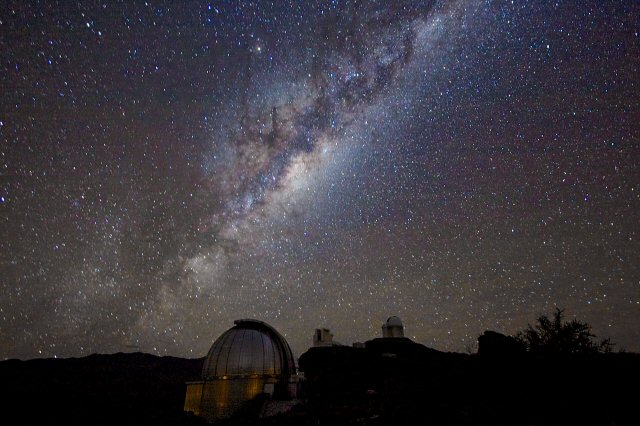 Figure 1.
A view of the Milky Way stretching across the sky. This picture was
taken in the southern hemisphere, in Chile. Image credit: A. Fitzsimmons/ESO.
Figure 1.
A view of the Milky Way stretching across the sky. This picture was
taken in the southern hemisphere, in Chile. Image credit: A. Fitzsimmons/ESO.  Figure 1.
A view of the Milky Way stretching across the sky. This picture was
taken in the southern hemisphere, in Chile. Image credit: A. Fitzsimmons/ESO.
Figure 1.
A view of the Milky Way stretching across the sky. This picture was
taken in the southern hemisphere, in Chile. Image credit: A. Fitzsimmons/ESO.
First of all, what does it look like? How big is it? Where are we located in it? Are we on the edge of it, in the middle, or somewhere in between? How can we tell? What do you see when you look at the Milky Way? When you go outside on a clear, moonless night (and you are in a site far away from the city), you can clearly see the Milky Way. It looks like a band of fuzziness that appears to stretch across the sky, though it isn't always easily visible. The best times of year to see it are the winter and summer months. This is when it is high above the horizon. Why does it look like that? That is where more stars and other material are located, so that gives it that fuzzy appearance. The fact that it is located in a band across the sky also gives us a clue about the Milky Way's shape - obviously it isn't a sphere - at least not where we're located, but is probably closer in shape to a flat object. In the old days, people thought that if they could measure the depth of the stars in the band they could get an idea about how big the galaxy is and possibly also our location in it. To your eyes, the distribution of stars in the sky looks pretty uniform. Could you point to any specific site and say, there is the center of the galaxy? Probably not, but if you were to assume that stars are fairly evenly spread out, you could count the stars in various directions and use that information to try to estimate our location in the Milky Way. In directions where you see many stars, you would probably believe that the galaxy stretched out a long way in that direction. In those directions where there are very few stars, you might think that the extent of the galaxy there is not so big - seems pretty straightforward, eh?
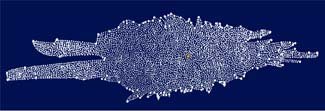 Figure 2.
An early image of the galaxy based upon counting stars. This shows the
Earth (and Sun) located near the center of a flattened distribution of
stars - not a good model of the galaxy.
Figure 2.
An early image of the galaxy based upon counting stars. This shows the
Earth (and Sun) located near the center of a flattened distribution of
stars - not a good model of the galaxy.
What sort of a picture of the galaxy do we get when we use this method? We get a galaxy with us located near the center of a small, flat disk (only a few hundred light years in size). Is this correct? Are we located near the center of the galaxy? That seems pretty unlikely - why would we be at the center of everything? I mean, we are pretty important, right, but are we really that important? NO! If this isn't the correct answer, what went wrong? Do we need to count the stars again? We could, but no matter how many times this experiment was done, the result was the same - we end up being in the middle of a relatively small galaxy. Why do we keep getting this result for the shape of the galaxy? What prevents us from seeing the actual shape? Just a whole bunch of gas and dust, that's what! It is sort of like a fog that limits how far we can see. It is a bit of a paradox - to see how far the disk of the galaxy extends, we have to look in the disk of the galaxy, and this is where all of the stuff (gas and dust) is that is blocking our view. We don't actually see very far when we look in the main part of the Milky Way, so when we map out our position using the stuff we can see with our eyes, it looks like we are near the center. Obviously someone needs to figure out a better way to do this.
If we want to try to locate our position in the galaxy, we need to use a method that will not be affected by the gas and dust in the plane of the galaxy. We need to look for things that are located away from the plane (disk) of the galaxy and that we can get a reliable distance from. What sort of objects are out there that allow us to do this? We're going to have to make a little detour back into the realm of stars, in this case some rather interesting Giant and Supergiant stars. You thought we were all finished with stars - no, not yet.
There is a region on the H-R Diagram where a star's structure (temperature, density, and pressure) will be slightly bizarre. These stars tend to not be in Hydrostatic Equilibrium. What does that mean? Do you remember what Hydrostatic Equilibrium is? It is the balance of gravity (pulling inward) and gas pressure (pushing outward). When a star is in balance, then the star is stable - if you kicked it, it would wobble a bit but eventually settle down. When a star is NOT in Hydrostatic Equilibrium, it won't settle down. In fact, if you were to kick such a star, it would not settle down but would expand and contract, expand and contract, and so on. A star that is not in Hydrostatic Equilibrium is like a faulty pressure valve. It will keep over compensating and under compensating, allowing in too much or too little air, or whatever the faulty valve is supposed to regulate. In the case of a star in this situation, the outer layers will expand and contract in a periodic manner as it blocks up and then releases energy. If you're changing the radius of the star during this expansion/contraction process, then the observed characteristics of the star will also change. Things such as luminosity (brightness) and temperature will be affected by these pulsations. The neat thing is that these variations are very well organized (periodic) - they occur in generally very well behaved cycles. All this occurs while the star is located in a region of the H-R diagram known as the Instability Strip.
The Instability Strip is located in the upper part of the H-R diagram, so the stars that tend to pass into it are either Red Giants or Supergiants. During a star's Red Giant phase, a star could cross the Instability Strip once, twice or more times depending on the type of evolutionary path it takes, which of course depends upon the mass. Once a star does enter the Instability Strip and starts to pulsate, we call it a variable star. There are actually many types of variable stars out there, but we'll only look at two of the main types.
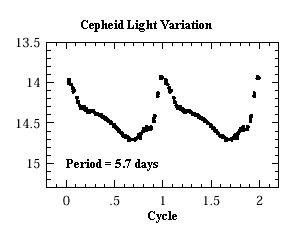 Figure 3.
Light variation of a Cepheid variable. It is plotted so that two
cycles of pulsation are shown.
Figure 3.
Light variation of a Cepheid variable. It is plotted so that two
cycles of pulsation are shown.
Cepheids are high mass pulsators and are often classified as Supergiants. They are so big that they tend to have long pulsation periods; after all, it takes a long time to move all of that material. They tend to have pulsation periods between 2 and 40 days, though some can have periods that are much longer. The masses of these stars are typically between 3 and 10 solar masses. To make matters a bit complicated, there are actually two types of Cepheids, which are easily distinguished according to the amounts of heavy elements (metals) in their compositions. The not so original names are
Cepheids are very nifty stars and provide us with some useful information. This is because of two aspects -
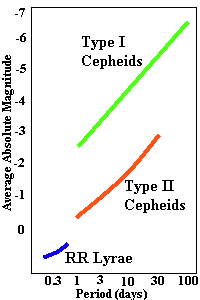 Figure
4. The Leavitt Law
for Cepheids is shown. The longer the pulsation period, the
brighter the star is on average. We have to say "on average" since
these stars vary their brightnesses, so the average brightness is along
the y-axis.
Figure
4. The Leavitt Law
for Cepheids is shown. The longer the pulsation period, the
brighter the star is on average. We have to say "on average" since
these stars vary their brightnesses, so the average brightness is along
the y-axis.
For these reasons, Cepheids are amongst the most important stars in the Universe. Why? You can get distances to the Cepheids and the galaxies they are located in - fairly accurate distances, in fact. How? First you need to determine the pulsation period of the Cepheid. This is pretty easy since all you have to do is watch it for a long time. Once you have that, you go to the Leavitt Law and determine the expected luminosity (absolute magnitude) of the Cepheid with that period. By comparing the expected luminosity (absolute magnitude) to the observed brightness (apparent magnitude), you can determine the distance that the Cepheid is away from you. Basically, you know how bright it should be, and you compare it to how bright it appears and the difference of those two is related to its distance. This is a very easy process and the results are very reliable. Cepheids are observed in other galaxies, so we can use them to find the distances to those other galaxies. The only complication is that there are two types of Cepheids, so you need to know which type you are observing since one type is more luminous than the other.
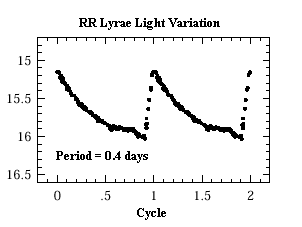 Figure 5.
Light variation of an RR Lyra star (Plural: RR Lyrae). Notice how much
shorter the period is than for the Cepheid. This is one of the ways
that they are distinguished from Cepheids.
Figure 5.
Light variation of an RR Lyra star (Plural: RR Lyrae). Notice how much
shorter the period is than for the Cepheid. This is one of the ways
that they are distinguished from Cepheids.
The other type of pulsating star is the RR Lyra (plural: RR Lyrae) type. These are small mass variables, generally much less massive than Cepheids, and even less massive than the Sun typically, but they pretty much operate the same ways as Cepheids in most respects. They are less massive, so they tend to have much shorter pulsation periods, typically less than one day for an entire pulsation cycle. They are also less luminous then the Cepheids (again, because they are much less massive). Unlike Cepheids there is no strong period-luminosity relation like the Leavitt Law, but they all tend to have about the same average luminosity (absolute magnitude). Basically, they all have about the same wattage (if you want to think of them as light bulbs). If you find an RR Lyra star, you know how luminous it is - about the same as all other RR Lyrae out there. As with Cepheids, you can compare the RR Lyrae's observed brightnesses to their expected brightnesses and use the differences to determine the distances to these objects. The only problem is that they are only useful for determining short distances since they are not as bright as Cepheids. While Cepheids can be both metal rich and metal poor, RR Lyrae stars are pretty much all metal poor.
Let's get back to the problem at hand, mapping out the Milky Way. How will these stars help us map out the size of the Milky Way and our location in it? We can use them because they are located in Clusters. You haven't heard about clusters yet? It looks like we'll have to make another side track.
If you find a group of stars that is physically associated (gravitationally bound), it is likely that these stars were born at the same time (remember how large scale star formation works?). This group is what is called a cluster. The really neat thing is that when these stars were formed, they would all have had different masses (again, remember how large scale star formation works - if you don't you might want to go back to that section). You know that different mass stars live their lives at different rates (high mass, short life; low mass, long life). Even though these stars were all formed at the same time, they would be in different phases of their lives depending upon how old the cluster is and how diverse the masses are. By looking at one group of stars, you could actually see stars in a wide range of stellar life stages. Actually, clusters of stars are fairly common and there are quite a few star clusters out there. These clusters fall into two main types.
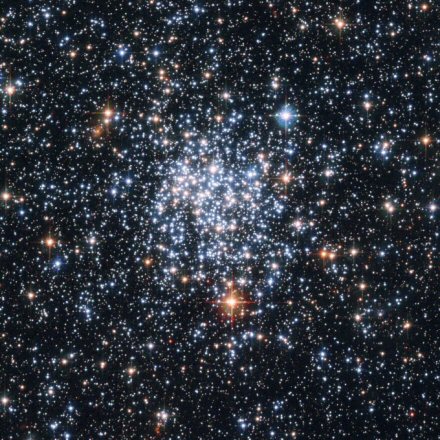
Figure 6. A typical Open Cluster. Notice how widely spread the stars are and how blue many of the stars are. Image NASA/ESA . |

The Pleiades, also known as the Seven Sisters, located in the constellation of Taurus. Image NASA/ESA/AURA/Caltech |
Open Clusters are also called Galactic Clusters and contain about 1000 stars or so. There are probably around 20,000 open clusters in our galaxy, and most are found in the main body of the galaxy (the plane). The extent of a typical open cluster is at most 30 pc. They are called open clusters since that sort of describes how they look - very wide open. The stars in them are all spread out and in no particular arrangement. The spacing between the stars is pretty big, with there being less than one star in a cubic parsec of space. An aspect of open clusters that makes them good objects to observe is the type of stars that are found in them - mainly young and hot stars that are very similar to the Sun in terms of composition. Many open clusters have rather bright, blue stars that make them easy to see. These clusters are chemically similar to the Sun (metal rich), so if they contain any variable stars, they would have Type I Cepheids. You have probably seen an open cluster and not even known it - there is a group known as the Pleiades (also called the Seven Sisters or Subaru) that is visible in the Winter and early Spring skys. Some people think that it is the little dipper (it isn't), and it is obviously a grouping. If you were to use some binoculars to look at it, you would see about 20-30 stars, all of which are part of the cluster. Other open clusters are also out there, but they are not bright and obvious as the Pleiades.
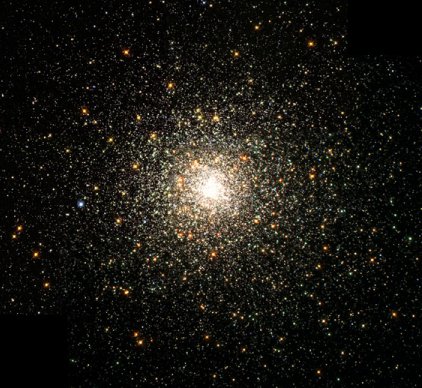 Figure 7.
A typical Globular Cluster, this one is known as M80 . Notice how
tightly packed in the stars are, as well as how yellowish-orangish many
of the stars appear to be. Image Credit: Hubble Heritage Team (AURA/
STScI/ NASA).
Figure 7.
A typical Globular Cluster, this one is known as M80 . Notice how
tightly packed in the stars are, as well as how yellowish-orangish many
of the stars appear to be. Image Credit: Hubble Heritage Team (AURA/
STScI/ NASA).
The other type of cluster is the Globular Cluster. Why are they called this? If you looked at them you would see a glob of stars all bunched up in the middle. Globular clusters contain many more stars than open clusters, typically about 1,000,000 stars packed within an area about 25 pc wide. This is the same amount of space that an open cluster occupies, but with the globular clusters, there are about 1000 times more stars. That is why these clusters look like globs; all the stars are bunched in so close together that they look like fuzzy cotton balls in a telescope. The spacing between stars in a globular cluster is much less than in an open cluster - stars may be only a small fraction of a parsec apart from one another in a globular cluster. The stars are so tightly packed together that they are in a very well organized system and appear in a dense spherical arrangement. Globular clusters are found out of the plane of the galaxy in general and are arranged in a spherical distribution about the center of the galaxy (this is a very important point, which we'll get to in a bit). These clusters contain old stars, which are generally deficient in heavy elements. Variables found in globular clusters include Type II Cepheids and RR Lyrae stars.
How do we know that globular clusters are made up of old stars, while open clusters have young stars in them? It is actually pretty easy to see. All you have to do is plot up all the stars in a cluster on an H-R diagram and see where they are located. In an open cluster, many of the stars are still on the main sequence, and only a small number have died and can be found in the red giant or supergiant region. You can actually see how the ages of clusters vary by how many or few stars are still on the main sequence - the basic upshot is that the shorter the main sequence, the older the cluster. Globular clusters are so old that they have very few main sequence stars remaining, while their easily visible stars are all hanging out in the red giant or supergiant area of an H-R diagram. It is pretty easy to see the relative ages of clusters. To get actual values for ages, we need to use computer models that can tell us how long it takes for the various stars of a cluster to die (which, as you remember from the previous section of the course, is dependent upon mass).

Figure 8. The evolution
of a star cluster is shown. In the first H-R diagram (far left), the
stars have just been formed. The high mass stars evolve faster, so they
are on the Main Sequence (red line) before the low mass stars. In the
second image, all of the low mass stars have made it to the Main
Sequence, but by this time, the high mass stars have already started to
die and are evolving over to the right. This trend continues in the
next two panels, and as the cluster ages the Main Sequence gets shorter
and shorter. By plotting up stars in a cluster it is possible to
compare their locations on the H-R diagram in order to determine the
age of the cluster.
You'll notice that both types of clusters have variable stars in them. Clusters can have either Cepheids or RR Lyrae in them, so we can determine the distances to them. How does this help? At first we weren't sure, but someone thought that they could use clusters to determine how far the center of the galaxy is from us. Which clusters would be the most useful? Open clusters are found in the plane of the galaxy and our view of them tends to be obstructed by all the gas and dust in the galactic plane. Obviously we don't want to use them. That leaves us with globular clusters. If you look at the globular clusters, you can map out their distribution around the galaxy by determining how far away they are, and we can do that since they contain Type II Cepheids and RR Lyrae. Someone did just that; an astronomer by the name of Harlow Shapley (who did the work around 1915) mapped out the locations of globular clusters and determined their distances using Type II Cepheids and RR Lyrae. What did he find?
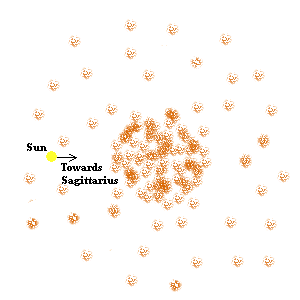 Figure 9. The distribution of globular clusters as
seen by Harlow Shapley. There is a strong concentration of clusters in
the direction of the constellation of Sagittarius, and they are quite a
ways from the Earth.
Figure 9. The distribution of globular clusters as
seen by Harlow Shapley. There is a strong concentration of clusters in
the direction of the constellation of Sagittarius, and they are quite a
ways from the Earth.
When you look in one particular direction (toward the constellation of Sagittarius), you'll see more globular clusters in that direction than in any other. This distribution indicated to Shapley that the center of the galaxy was in the direction of the constellation of Sagittarius. He also saw how the clusters were spread out in a rather spherical distribution that radiated from the direction of Sagittarius, which indicated that the center was not anywhere near us but somewhere far away toward the direction of Sagittarius. By looking at the typical distances of the globular clusters in the direction of Sagittarius, he determined how far away the center was from us (our solar system) and it was much greater than anyone ever thought possible.
It took quite some time for the rest of the astronomical community to accept Shapley's model of the galaxy, but now we know that his method was basically correct. Later observations confirmed his result that we (our solar system) are nowhere near the center of the galaxy. Nowadays, astronomers use radio telescopes, which can see through the gas and dust at certain wavelengths, to map out the size of the galaxy and our location in it. Now we can see through the "fog" of the disk and get a pretty accurate view of the galaxy. It is pretty amazing that Shapley was able to do pretty much the same thing by using the tools he had and getting pretty much the same result we get today. We can also compare our own galaxy to others to give us more clues about the size, shape and content of our galaxy. We now have a pretty good idea of the arrangement of the stuff in our galaxy, and this is shown below.
There are several major parts, including the
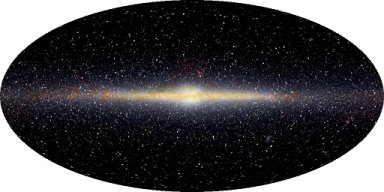 Figure
11. An infrared telescope
view of the entire sky showing the locations of the disk of the galaxy
and the bulge. This view has the center of the galaxy in the middle.
The extent of the bulge show how well named it is.
Image is courtesy E. L. Wright (UCLA), The COBE Project, DIRBE, NASA.
Figure
11. An infrared telescope
view of the entire sky showing the locations of the disk of the galaxy
and the bulge. This view has the center of the galaxy in the middle.
The extent of the bulge show how well named it is.
Image is courtesy E. L. Wright (UCLA), The COBE Project, DIRBE, NASA.
The center of the galaxy is located within the bulge, which, as the name implies, bulges out from the flat disk shape. Not only is it bulging out, but it is made up of distinct stars, in this case those that appear reddish or yellowish (relatively cool stars). We see this kind of coloring in other galaxies also. There is so much junk between us and the center that we don't have a very good view of the bulge with visible light telescopes. However, those clever astronomers can use other types of telescopes, and when they do, they notice that the bulge doesn't really have a spherical shape but is sort of stretched out, kind of like a cigar, so that the center actually has more of a bar-like structure. This is kind of important, since it helps us to classify the type of galaxy we live in (we'll get to galaxy types in the next set of notes). The size of the bulge isn't exactly known, but it appears to be about 2000 parsecs (or 2 kiloparsecs) in radius, though it could be a bit larger or smaller - it's hard to tell, especially since there is so much junk in that direction preventing us from getting a good view. Now here's a rather strange feature - even though there is a bunch of dust and gas between ourselves and the bulge, there isn't a whole lot of gas and dust within the bulge - a very important aspect as to what does and does not occur in the bulge (as you'll see in a little bit).
You may have noticed that there is now a new unit of measure given above, the kiloparsec (kpc). This is just the same as a 1000 parsecs and is a pretty convenient unit of measure for sizes within the galaxy. You could also use kilo light-years, but no one is ever sure how to abbreviate that.
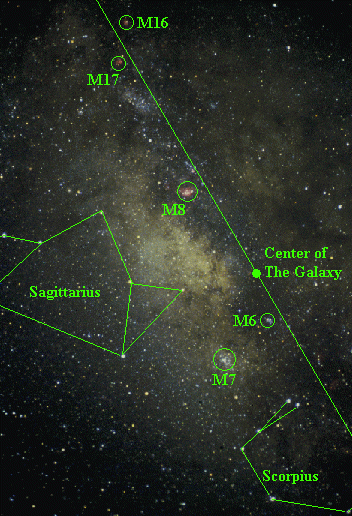 Figure 12.
A view looking toward the direction the Milky Way's center using a visible light telescope.
Some bright clusters and star formation regions are indicated as well
as the location of some of the stars of Sagittarius and Scorpius. The
point in the sky that is the direction toward the center of the galaxy
is also shown. The line shows the orientation of the disk of the galaxy.
Figure 12.
A view looking toward the direction the Milky Way's center using a visible light telescope.
Some bright clusters and star formation regions are indicated as well
as the location of some of the stars of Sagittarius and Scorpius. The
point in the sky that is the direction toward the center of the galaxy
is also shown. The line shows the orientation of the disk of the galaxy.
Let's get back to the bulge. What is in the center of this bulge? It isn't really easy to tell, again because of all the gas and dust blocking our view. There are of course views with other telescopes, and radio, infrared and x-ray telescopes have given us a lot of information about what's happening there. One of the first clues was that in the center of the galaxy is a very strong radio source. In the wonderfully creative way that astronomers name things, they decided to call this strong radio source Sagittarius A, or Sgr A for short. Isn't that clever? As radio telescopes got better and better, astronomers were able to see more detailed structures and see that there were more objects in the middle than just one radio source. In fact, there were a whole bunch of other objects giving off all sorts of radio signals. After a while, there was Sgr B, Sgr B1, Sgr B2, Sgr C, Sgr D, Sgr E, ... pretty sloppy, eh? Any ways, astronomers have finally weeded out the sources and have come upon one that is stronger and more centrally located than all of the others, which is called the Sgr A*, and this is the thing that is at the center of the galaxy. They were also able to identify many objects that aren't visible with a visible light telescope that we have yet to understand. Some of these are shown in Figure 13.
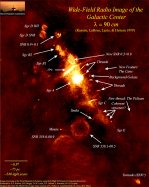 Figure 13. Click on the image to see the
full picture. A radio telescope view of the center of the galaxy. Many
features are seen including supernova remnants (SNR), H II regions and
other objects whose nature has yet to be understood. The view seen here
and that in Figure 12 are in the same orientation. You can see this by
how the stuff is arranged along a diagonal line, which is the plane of
the galaxy. Image credit: N. E. Kassim, D. S. Briggs, T. J. W. Lazio,
T. N. LaRosa, J. Imamura (NRL/RSD).
Figure 13. Click on the image to see the
full picture. A radio telescope view of the center of the galaxy. Many
features are seen including supernova remnants (SNR), H II regions and
other objects whose nature has yet to be understood. The view seen here
and that in Figure 12 are in the same orientation. You can see this by
how the stuff is arranged along a diagonal line, which is the plane of
the galaxy. Image credit: N. E. Kassim, D. S. Briggs, T. J. W. Lazio,
T. N. LaRosa, J. Imamura (NRL/RSD).
We've determined that Sgr A* is what's at the center of the galaxy. What's it like? First off, it isn't very big. It may only be a few A. U.s in size (about 10 A.U. or so). Observations of stuff around it show that Sgr A* is not moving, but that there is a bunch of stuff going around it. By looking at the speeds at which this stuff moves and their distances from Sgr A*, and by using Kepler's third law, you can figure out the mass of the stuff in the center - the mass of Sgr A*. Hold on to your hats, campers, since the mass of Sgr A* comes out to be about 3.7 million times the mass of the Sun! Egad, that's huge! You have something much more massive than the Sun in a region of space smaller than our solar system. I wonder if it is a black hole? This seems to be a popular idea, especially when we look at other galaxies and see sort of the same thing there. In case you were wondering, a black hole that is 3.7 million times the Sun's mass would have a Schwarzschild radius of about 8 million km. This radius is about 10 times the radius of our Sun. Such a black hole could easily fit inside our solar system.
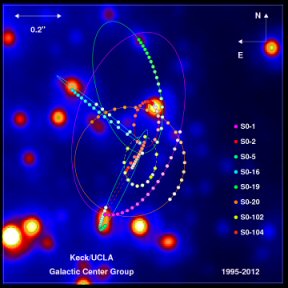 Figure 14. The motions of stars near the
center of the galaxy are mapped out and this helps astronomers
determine the mass of the object located at Sgr A*. More information
about this research can be found here.
Image from Andrea Ghez et al, 2012
Figure 14. The motions of stars near the
center of the galaxy are mapped out and this helps astronomers
determine the mass of the object located at Sgr A*. More information
about this research can be found here.
Image from Andrea Ghez et al, 2012
Sgr A*, or at least what we see, is itself not a black hole, since you can't see a black hole. It is likely that it is a disk of material around a massive black hole (an accretion disk). That is one of the reasons it is such a strong source of radiation. Also, the type of radiation (in this case synchrotron radiation) tells us that there is a strong magnetic field around the monster in the middle. What's feeding this monster? Actually, not a great deal of stuff. For the amount of energy that is coming out of Sgr A*, you need only drop in about 0.1 solar masses of material each year - so it doesn't suck in a huge amount of stuff, but just needs a steady stream of material. In 2014 a large x-ray flare-up was detected by the Chandra telescope, which may have been caused by various things falling into the black hole (their destruction released the x-rays), or the strong magnetic fields associated with the black hole. Either way, it is not a nice neighborhood.
If you look at all of the stuff around Sgr A* (all those other Sgr things), some of the objects are recognizable as supernova remnants. Actually, there are quite a few in that direction of the sky (remember, you have to look through a lot of the disk to see the center). There are also a bunch of unusual features streaming out from the center - things known as threads. As usual, we're still working on figuring out what these things are, so stay tuned; perhaps one day we'll figure them out (but don't hold your breath).
You're probably wondering how you could have objects near a massive black hole without their destruction, like the stars shown in Figure 14. That's a tricky problem since many of the objects that are observed are young, massive stars, so they could not have formed elsewhere and just happened to pass close to Sgr A*. A recent study showed that it is possible for stars to actually form in the neighborhood of Sgr A*, in particular in the disk of material that is likely to exist around the black hole. The density of the disk "protects" the newly forming stars so they aren't shredded by the black holes strong gravity - and they may be forming at a distance from the black hole where it is relatively safe (though how you can ever be safe near a black hole is beyond me). Check out this animation that shows how stars might currently be forming in this dangerous environment.
Outside of the region housing Sgr A*, the bulge of the galaxy isn't very exciting. In fact, the bulge sort of looks like an overgrown globular cluster, since many of the stars in it are rather old, cool and yellowish looking. There is some debate, but there doesn't appear to be a huge amount of star formation going on in the bulge of our galaxy. If you want to look where stars are actually forming in a big way, you need to go to the disk of the galaxy. One aspect about the bulge of our galaxy that is interesting is its shape. The bulge isn't really spherical in shape like a globular cluster, but is actually stretched out into a bar shape, which is a fairly common type of structure seen in galaxies like ours (what are called spiral galaxies). Astronomers in Wisconsin found that the bar extends quite a ways out, about 4 kpc from the center. This is about 1/2 of the distance from the center of the galaxy to the solar system, so that's a pretty big bar. And in case you were wondering, no they don't serve any tequila at this bar.
The disk is where most of the action occurs in the galaxy, where most of the visible material is, and where the planets, gas clouds, stars and other things hang around. Also, because of all of that gas and dust, this is the region where star formation is really active - it's pretty much the only part of our galaxy where stars are constantly being formed. The disk is quite large, about 30 kpc from end to end (or, if you prefer, it is 100 kilo-light years from end to end). It isn't very thick; it's only about 300 pc thick (1000 light-years). As mentioned previously, we aren't near the center or the edge but sort of midway between the center and the edge, about 8.0 kpc (26 kltyr) from the center, and we're not even in the mid-plane of the disk but about 20 pc from the mid-plane - definitely in the suburbs. There is still some debate about how far we are from the center of the galaxy. Some astronomers think it may be as large as 8.4 - 8.5 kpc, while other favor a value closer to 8.0 kpc. As you'll see, this part of the course is an area where the words "about" and "approximtely" will pop up quite a bit, so keep in mind that these numbers may be revised in the future.
Why does the galaxy have a disk shape? It is easiest to explain by looking at how the galaxy formed. It likely was rotating to some degree when it formed and this motion would have caused material, as it fell inward, to form into a flat disk. The same process can explain why the planets in the solar system are located in pretty much the same plane around the Sun (the ecliptic).
We know from our early attempts to map out the size of the galaxy that the structure of the disk can not be seen with optical telescopes due to the gas and dust. We instead need to use radio wavelengths to measure the amount of material there. A very good radio telescope wavelength to use is 21 cm, which indicates the presence of H I (this is regular, normal hydrogen). Using this wavelength, it is possible to detect where the gas is located, especially if it is in a concentrated form. Not only is H I detectable, but so are a wide range of other molecules in the disk. Actually, things like alcohol and sugar molecules have been found in space. I don't know if you can make a margarita out of them, but it's out there.
If you want to see what the disk of the galaxy looks like at various wavelengths, just check out this link.
There's all this gas in the disk (as well as dust and giant margaritas - no, I'm making that last bit up). What is this gas doing? Some of it (if you remember a few weeks ago in the course) was involved in the formation of stars. The disk is where this action occurs - not just anywhere in the disk, but in the spiral arms. That is the pretty pin-wheel structure you see when you look at pictures of galaxies. Why does the star formation only occur in the spiral arms? Why doesn't it happen everywhere in the disk - isn't there gas everywhere in the disk? What's up with that? Why can't you ever open those little packets of ketchup that you get with your fries? I don't know about the last question, but I'll try to tackle the stuff concerning the galaxy.
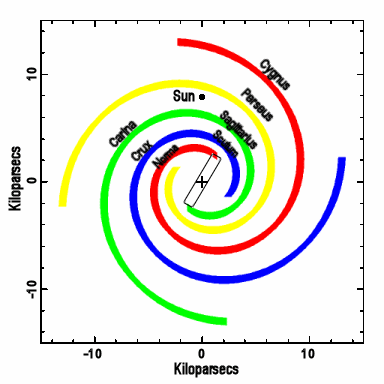 Figure 15.
A possible map of the spiral structure of our galaxy. The map is based upon
observations of various segments of spiral structure and theory of how
the structure should behave. In this model, there are 4 spiral arms
and the Sun is located about 7.9 kpc from the center of the galaxy
(marked by a +). While this appears to show where the arms are, other
maps by other astronomers show different features or
a different number of arms. Based upon data from
J. P. Vallee (2005).
Figure 15.
A possible map of the spiral structure of our galaxy. The map is based upon
observations of various segments of spiral structure and theory of how
the structure should behave. In this model, there are 4 spiral arms
and the Sun is located about 7.9 kpc from the center of the galaxy
(marked by a +). While this appears to show where the arms are, other
maps by other astronomers show different features or
a different number of arms. Based upon data from
J. P. Vallee (2005).
First of all, the spiral arms or spiral structure that you can see is due to the star formation - these things stand out like a great big zit on prom night. Actually, they are a bit bigger. The arms are bright because of large scale star formation. If you remember what happens with large scale star formation, you'll recall that there are all sorts of bright big things in these areas. If you were to look at the locations of the spiral arms, what would you see? You'd see things like Giant Molecular Clouds and the most massive stars that are formed (OB types). You'd also see the things around such objects like the H II regions. Even though spiral arms are associated with stellar birth, since the big stars die quickly, you can find their remains in the forms of supernova remnants right next to the locations of their births. All of these big or bright things are used to trace out where the spiral arms are, and to help us determine how many spiral arms there are. That's why we call them spiral arm tracers. Astronomers take a look at these things, map out their positions in the galaxy (as best they can), and try to determine what the shape of the spiral structure in our galaxy is like. What is the answer? We aren't sure. That's the annoying phrase you're going to see quite a bit over the next few weeks. Even though we can see the stuff pretty easily and try to figure out their locations, we're never in agreement. Some astronomers think that there are two spiral arms, some think there are four, some think there are two but they are very sloppy, some are completely clueless, and some could care less. How many arms are there? I have no idea. There are probably two arms, since that is the most common number, and it is likely that they are a bit sloppy so it looks like there are more, but that's about the best we can do right now. You know, mapping out the spiral structure of a galaxy when you are in the galaxy is like trying to make a map of an entire city when you are stuck on just one street corner and you can't move around at all. It isn't easy.
In spite of the difficulties astronomers keep working on the problem. One feature that extends out from the bar at the center of the galaxy is known as the 3-Kpc arm (since it is about 3 Kpc from the center). It is possible that this is the "base" of one of the Milky Way's spiral arms. Recently it was determined that there is another 3 Kpc on the other side of the galaxy (see the press release about this from Harvard here). This would lead some to think that the Milky Way has 2 spiral arms as is shown in the press release images. Is that correct? Well the Harvard study was announced in June 2008. 6 months later, an astronomer at Iowa State University announced the measurement of the 4 spiral arms! So which is it? Expect more discussion in this area in the future....
If we can't tell what the structure of the spirals in the disk is like, can we at least figure out what the disk material is doing? Remember, there is more stuff to the disk than just the spirals - those are just the most obvious things. There is a lot more stuff out there that isn't so obvious, and it has mass, so it must obey some sort of law as to how it goes around the galaxy, but how does it do this? If things went around the galaxy the same way that planets go around the Sun, you would have the stuff far from the center moving very slowly (that's what Kepler's 3rd law tells you). It could also rotate like a solid - the way a record or a cd spins around. In that case, the stuff far from the center goes the fastest. What does the disk of the galaxy do? How does its material move?
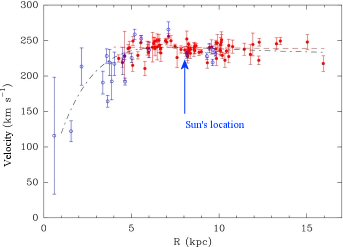 Figure 16.
The rotation curve for the Milky Way. The curve varies at different
distances from the center. Our location is at roughly 8 kpc from the
center. Graph is from a paper by M. J. Reid, et al., 2014. Click on the image to see a larger version.
Figure 16.
The rotation curve for the Milky Way. The curve varies at different
distances from the center. Our location is at roughly 8 kpc from the
center. Graph is from a paper by M. J. Reid, et al., 2014. Click on the image to see a larger version.
The best way to figure out how the disk moves is to follow the motions of the most common stuff in the disk - those big clouds of gas (H I) that are all over the place. These clouds and other clouds like CO or CO2 give us a pretty good idea of how the disk moves, and that is shown in Figure 16. We don't really have a good picture of what is going on in the middle (in the bulge), but for most of the galaxy, we have a good view of the action. We (the solar system) go about the galaxy at a speed of around 220 km/s and it takes us about 225 million years for one trip around.
Here is a nifty idea. What if we pretend that we are orbiting the center of the galaxy? If we do that (and that isn't such a wild idea), then we can use Kepler's 3rd law to figure out the mass of what we're going around. Why is that? If you remember, and I'm sure you do, Kepler's third law can be rewritten as
M1 + M2 = a3/P2
where a is the distance from the center (in AU) and P is the orbital period in years. The values for M1 and M2 are the mass of what your going around (the galaxy's mass within our orbit) and your mass. The masses of the Earth, Sun, Moon, and all the rest of the stuff in our solar system is really dinky compared to the mass of the galaxy, so we can simplify the formula to
Mgalaxy = a3/P2
where we'll just ignore our own mass. Here's a really nifty thing - we can determine the mass of our galaxy, or at least part of it (the amount within our orbit), just by looking at how long it takes us to go around the galaxy and how far we are from the center. When we use the numbers we know and convert them into the appropriate units, we get a mass of about 1011 solar masses - 100 billion times the mass of the sun. Wow, that's a lot! Actually, that really isn't since we are only measuring part of the mass of the galaxy - this is the amount of material we measure going out only about half way from the center. If we look at other parts further from the center and do the same calculations, we get some really large masses - sometimes values like 1012 solar masses. That's a lot. Are we sure about this? Yes, because if you look at how the galaxy rotates in the other parts, we see that the velocity stays pretty high or even increases. The only way to sustain this high velocity is to have a large amount of mass in the outer galaxy. Without the mass, the velocity would drop off. It's not like our galaxy is a weirdo; we see the same thing with other galaxies similar to our own.
There is only one problem with this large amount of material. We detect a large amount of mass in the outer part of the galaxy based upon the way stuff in our galaxy moves, but we can't actually see all this stuff. The outer parts of galaxies (not just ours, but others like it) appear dimmer than the parts closer in. This material that makes up a large fraction of the mass of the galaxy just doesn't show up very well - it is very hard to see. Astronomers call this dark unseen matter (oh, you'll love this name) dark matter. How's that for a very clever name? Actually, it sort of makes sense, because there is quite a large amount of matter, but it doesn't show up in our telescopes - and I just don't mean the telescopes that detect visible light, but also other types of telescopes. We'll run into more dark matter later on, so keep it in mind.
You may have noticed that in the outer part of the galaxy the rotation curve is fairly uniform - that stuff is moving at roughly the same speed. Isn't that special? Actually, it may be a disaster. If the velocity is the same value or nearly the same value for stuff at all of those different distances from the center, then things at those distances will travel roughly the same distance around the galaxy in the same amount of time. Say you have a straight line drawn from the edge to the center of the galaxy. If you let it go for a while, the inner part of this line will get around the galaxy before the outer parts of the line, since it has a shorter path to travel. After a relatively short time, what started out as a straight line would wind up completely. If a straight line would wind up, wouldn't all other structures also "wind up"? How come we have spiral arms then? Why aren't they all wound up? The solution is rather simple: The spiral pattern (spiral arms) do NOT travel at the same rate as the material in the disk. They travel through the disk but they don't move in the same way that the disk material does (which is shown in Figure 16). That's about as confusing as it gets. How can the spiral arms travel at a different reate than the stuff in the disk? Aren't they in the disk? Yes, they are, but they are not solid objects. The spiral pattern is like a sound wave traveling through air. The sound doesn't cause material to move around a great deal, it just passes through the air and compresses it as it goes along. This is sort of what is going on in the spiral arms. The concept that explains this is known as the spiral density wave theory, but I like to call it the naked jogger model. Let me explain it first to show you what I mean.
Let's say you have a bunch of cars going down the freeway. They are moving along at a steady pace and are well spaced. Now, let's put along this freeway a nude jogger. You get to choose the gender of the jogger. Now we have a nude jogger going down the road, and what is going to happen to the traffic? Obviously, the traffic is going to get bottlenecked in the area of the nude jogger. It won't stop; it will just slow down and get congested for a while. The location of the freeway that experiences this congestion will gradually change - it will move along as the jogger moves along. Far from the jogger, things are pretty normal, whereever the jogger is, things are congested.
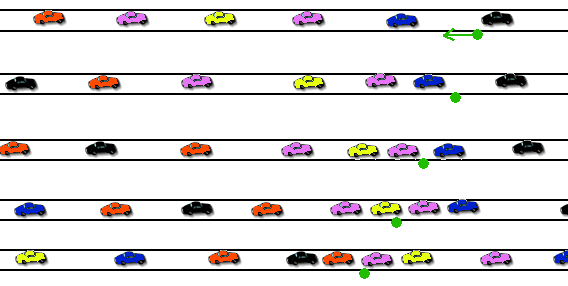 Figure 17. An analogy of how the spiral arms move
through the disk. The cars are moving down the highway toward the
right. At first they are well spaced. A nude jogger is represented by
the green dot (you thought I would include a picture of a nude jogger?!)
and the jogger is moving toward the left. As the jogger moves down the
side of the road, the traffic near the jogger slows down and gets
congested. The area of congestion moves down the highway at a pace that
is independent of the stuff moving into the congestion area. The cars
represent disk material, the jogger represents the density wave
and the congestion is the star forming regions.
Figure 17. An analogy of how the spiral arms move
through the disk. The cars are moving down the highway toward the
right. At first they are well spaced. A nude jogger is represented by
the green dot (you thought I would include a picture of a nude jogger?!)
and the jogger is moving toward the left. As the jogger moves down the
side of the road, the traffic near the jogger slows down and gets
congested. The area of congestion moves down the highway at a pace that
is independent of the stuff moving into the congestion area. The cars
represent disk material, the jogger represents the density wave
and the congestion is the star forming regions.
What the heck does a nude jogger have to do with the spiral structure of our galaxy? It is just like it! The jogger is a density wave (just like the spiral pattern); in the area of the jogger, traffic is congested (just like a GMC gets compressed in a spiral arm). The jogger is moving independently of the stuff he/she compresses (just like the spiral pattern moving through the disk material). So, in a galaxy, you have a really large nude jogger - no, not really. You have a region of compression that travels through the galaxy, and it goes independently of the stuff it compresses (the gas clouds). We know where it is, because the compression causes star formation and that shows up as the things we call the spiral arms. I guess this would be like the nude jogger causing a few fender benders.
Let me re-cap: the spiral density pattern moves through the disk at its own speed, compressing the disk material as it goes along, causing star formation - which is what we see as the spiral arms. The stuff in the disk - the gas, the stars, all that stuff - moves according to the rotation curves we measure (like in Figure 16), while the pattern moves in its own sweet way.
Why is there a spiral density wave moving through our galaxy? We're not really sure where it came from or what keeps it going, but there are some ideas about how galaxies evolve that we're still working on. Perhaps you should re-take this course in about 10 years; we might have the answers by then.
This one is pretty simple - this is the region around the galaxy where you find globular clusters. It is actually a large, spherical region that surrounds the galaxy's disk. We can estimate its size by looking for RR Lyrae stars in distant globular clusters. When we look at the velocities of these distant objects, we know they are moving fast due to the presence of a large amount of dark matter in the halo. Again, we're not quite sure what the dark matter is, but there is a whole bunch of it out there.
That pretty much wraps up what we know about our galaxy - pretty spiral, unknown number of arms, probable black hole in the core, spiral density wave (what makes the spiral pattern) helping in the formation of stars, and a large fraction of its mass remaings unseen (all that dark matter).
While some people think of galaxies as pretty well defined objects, they really are not. They don't have abrupt edges but tend to thin out in terms of the amount of material they have, over large distances. When we say the size of the Milky Way is around 100,000 light years across, that is clearly an approximation, since material can be found at even greater distances from our galaxy. We also have some streams of material that is associated with our galaxy and extends well outside of the normal "edges" of our galaxy. Astronomers generally believe that these streams are material that was once part of our galaxy or another galaxy, that has been gravitationally stretched. You can think of this as sort of cosmic breadcrumbs left behind as a small galaxy or globular cluster gets shredded by the Milky Way. As you can see here, the streams extend quite a ways from the disk of the galaxy.
Before we start looking at other galaxies we have to talk about stars again. You have to remember that when you look at distant objects, you can't always see things as individual objects. You usually can't see individual stars at great distances; instead you see all the stars in a region (or a galaxy) as one glowing fuzzy blob. This is exactly what Walter Baade saw when he was looking at other galaxies. It was during World War II, and Baade was a German national who was working in the US. He could not do war research like the other scientists were doing at the time, so he spent all of his time up at the Mount Wilson Observatory in southern California. Normally, this is a really lousy place to look at the sky due to all of the light pollution from Los Angeles, but during the war the city was under a black out, so the night skies were really beautiful. Baade took advantage of these conditions to observe the Andromeda Galaxy, a large nearby galaxy similar to our own in its structure. He noticed that the inner and outer parts of the galaxy were different. He also noticed that the stars in the center of the Andromeda Galaxy and the stars in the direction of our own galaxy's bulge looked very similar. He decided that the stars in the inner part (bulge) and the outer part (spiral arms) were different. In the fine tradition of really original astronomical names, he decided to name these two groups of stars Population I and Population II stars.
Population I stars are found in the disk around the locations where you find young stars. These stars have compositions like the Sun (particularly in terms of how much iron and other heavy elements are in them). You find this population in areas where you have current star formation occurring - this is a big clue as to where they are and are not seen - you look for star formation! The Sun is a Population I star - hooray, we're #1, we're #1! Pop I stars are found in regions of star formation, so they tend to contain very hot stars and give the regions they are found in a rather blue-ish appearance. Population I stars tend to have rather boring orbits, since they are found in the disk of the galaxy - they pretty much stay close to the disk.
Population II stars are found in actually two places - away from the disk, in the halo where the globular clusters are, and in the bulge. These are places where there is no current star formation, so you are only looking at old stars in these locations. These old stars are metal deficient (low in the amount of iron in them) when compared to Population I stars and tend to look rather reddish. Population II stars have very wild orbits; they are all over the place with respect to the disk. While they tend to orbit about the center of the galaxy, some go up, some go down, some go this way and that. They aren't as orderly as the Population I stars.
It should be noted that stars, gas, and dust in the disk are continually being recycled with each new generation of stars. The first stars that were formed would have had only hydrogen and helium in them. When they died and blew their guts out in supernova explosions or planetary nebula phases, they scattered the heavier elements (which were produced during fusion or supernovae/explosive events) out into space, along with hydrogen and helium, of course. Later generations of stars are then made from these elements (along with any other stuff in space, which was still mainly hydrogen and helium). Population I stars are the way they are since material from many previous generations of stars was incorporated into them when they were formed. As time goes on, with more stellar birth (and death), the metal content of the galaxy's disk will increase. As long as stars are continually being formed, they will be made of more and more metal rich material (carbon, oxygen, iron, nitrogen, etc). Without continuous stellar birth and death, the metal content of the galaxy would not change but would stay at the same level. This is what we see in the halo and bulge of our galaxy (remember, they don't have current star formation, so their metal content hasn't changed much). This metal content-stellar population-star formation interconnectedness will be obvious when we look at other galaxies.